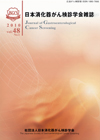Current issue
Displaying 1-11 of 11 articles from this issue
- |<
- <
- 1
- >
- >|
Prefatory Note
-
2024 Volume 62 Issue 2 Pages 106
Published: 2024
Released on J-STAGE: March 15, 2024
Download PDF (542K)
Original article
-
2024 Volume 62 Issue 2 Pages 107-113
Published: 2024
Released on J-STAGE: March 15, 2024
Advance online publication: December 29, 2023Download PDF (1191K) -
2024 Volume 62 Issue 2 Pages 114-124
Published: 2024
Released on J-STAGE: March 15, 2024
Advance online publication: January 31, 2024Download PDF (2664K)
Abstracts of Branch Meetings
-
2024 Volume 62 Issue 2 Pages Index03_1-Index03_2
Published: 2024
Released on J-STAGE: March 15, 2024
Download PDF (426K) -
2024 Volume 62 Issue 2 Pages 125-130
Published: 2024
Released on J-STAGE: March 15, 2024
Download PDF (783K) -
2024 Volume 62 Issue 2 Pages 131-145
Published: 2024
Released on J-STAGE: March 15, 2024
Download PDF (1043K) -
2024 Volume 62 Issue 2 Pages 146-159
Published: 2024
Released on J-STAGE: March 15, 2024
Download PDF (993K) -
2024 Volume 62 Issue 2 Pages 160-175
Published: 2024
Released on J-STAGE: March 15, 2024
Download PDF (1121K) -
2024 Volume 62 Issue 2 Pages 176-183
Published: 2024
Released on J-STAGE: March 15, 2024
Download PDF (875K) -
2024 Volume 62 Issue 2 Pages 184-198
Published: 2024
Released on J-STAGE: March 15, 2024
Download PDF (1056K) -
2024 Volume 62 Issue 2 Pages 199-218
Published: 2024
Released on J-STAGE: March 15, 2024
Download PDF (1094K)
- |<
- <
- 1
- >
- >|
